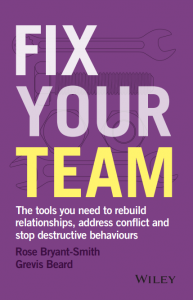Identifying when the workplace, or a team, is heading ‘downward’ or showing signs of negative momentum, can sometimes be tricky. As an employer, you don’t always have visibility over the extent and causes of workplace problems. Bad behaviour and dysfunction can be hidden within teams, geographic areas, functional groups, or management hierarchy.
Some of the signs, behaviours, and symptoms that we often see in dysfunctional workplaces are:
(a) Negative conversations overcrowd creativity and productivity
Teams can shift toward productivity or risk, depending on the group’s overall discussion. When we begin to notice the team shift or lean in favour of negative discussions, group polarisation can occur and the team can easily shift toward a more extreme decision that takes them in a less than ideal direction.
Employers will often say that there are fractions or a ‘divide’ between the team members which is contributing to the dysfunction. In our experience however, sometimes this is not the case, as the team usually find consensus in their views about important issues (or in some cases trivial matters) impacting them.
Nonetheless, our participants might say that they can ‘cut the air with a knife’ or refer to an unpleasant feeling or energy in their work environment despite there being concurring opinion.
(b) People look for strength in the loudest voice, and not necessarily the right voice
A naturally occurring event following group polarisation is usually ‘groupthink’. Groupthink occurs when members of the team suspend their critical judgement or censor their dissent in order to conform.
At this point, employees may stop talking to each other, or ‘mindguards’ will shield the team from receiving information other than which is supportive of the ‘groupthink’.
When this occurs, the majority of the team members begin to appear to think alike and we begin to observe an “us vs them” or anti-establishment type behaviours which sustain a ‘downward’ trend for team cohesiveness.
(c) High performers become quiet, employee absenteeism increases and the best employees begin to find new jobs
This one is pretty self-explanatory, but it can also be an indication that earlier warning signs were missed.
Understanding the signs and symptoms of what makes a dysfunctional team does not mean that all is lost, and that you should either literally or metaphorically, seek out formal complaints or place blame on any one particular individual in order to turn the team around.
One way to identify problems, risks and opportunities to improve morale, efficiency, functioning and ethics of the team is by conducting a workplace or team review.
By conducting a workplace review, you can proactively explore the causes and possible resolutions for identified workplace problems. The ultimate goal of a workplace review is to bring people together, to understand the situation, validate their concerns and identify practical interventions you can take, to make real improvements. Often the team is already in a high-conflict situation when you do reach the point of needing to conduct this type or review however taking the approach to conduct a workplace review, as opposed to formal investigation, may well create the synergy you require to perpetuate the actions required to improve or eliminate the problems.
In this context, a workplace review offers an opportunity for an employer to ‘keep ahead of the game’ by flushing out issues that are bubbling away under the surface. But it can also present an opportunity to challenge the concurring views of employees and prevent them from bathing in each other’s misery. For example, a workplace review will often highlight issues around role clarity or the need for simple things, such as new work equipment to make the job easier, giving the organisation the opportunity to improve work practices and processes in most cases, almost immediately.
As managers and team leaders, it isn’t always possible to have all the answers. But what you can do is create an environment where your people feel capable and confident to lead with positive momentum. Workplace Reviews are a simple, yet highly effective way, to collect the contributions and insights of all employees in order to reduce risk and improve productivity and workplace culture. It is sometimes the thing you need to create the self-awareness the team requires to instigate the change they seek themselves.
If you sense in your workplace, that something is ‘not quite right’, you don’t have to wait to receive a formal complaint. Trust your instincts and address the ‘elephant in the room’ but don’t do it alone.
Turning a team or work environment upward can be an overwhelming task at the best of times, but its about creating a positive momentum as employers and having a game plan to avoid failure, and that’s where we come in. At Worklogic we conduct independent workplace reviews and can provide independent, practical and actionable advice about the steps you can take to improve workplace culture, reduce risk and improve productivity and compliance.
To find out more about our process, or the steps you can consider taking to create your own positive momentum, get in touch!
Fix Your Team

If you suspect something isn’t right in your team, you can also read our latest book, Fix Your Team, published by Wiley and launched this month.
Co-authored by Grevis Beard and Rose Bryant-Smith, Fix Your Team gives you the tools you need to rebuild relationships, address conflict and stop destructive behaviour in the workplace. With Fix Your Team, you can identify causes of team dysfunction and get your team back on track. Essential reading for every manager and team leader! Buy now!
About Bronwyn Tolhurst


If you need help to Fix Your Team, then please do contact us for an obligation-free, confidential discussion.
Subscribe to the Worklogic blog to receive expert advice on resolving workplace complaints and building a positive culture at work direct to your inbox each week!

